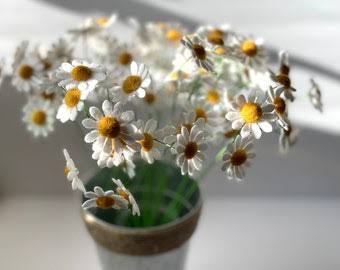Few plants capture both beauty and usefulness as perfectly as chamomile. With its delicate daisy-like blooms, calming fragrance, and powerful health benefits, chamomile has been cherished for centuries in gardens and households across the world. Whether you want to enjoy a soothing cup of tea, create natural skincare remedies, or simply brighten your garden with cheerful blossoms, learning how to grow chamomile successfully is rewarding.This guide will show you why 👌 so simple, so clever: chamomile flowers done right! is more than just a catchy phrase—it’s the ultimate way to grow, harvest, and use this versatile plant. Perfect for readers in the United States, United Kingdom, and Canada, this article offers practical steps, expert tips, and creative ideas to make chamomile a star in your home and garden.Why Chamomile Belongs in Every GardenChamomile is more than just a pretty flower—it’s a powerhouse herb with multiple uses:Soothing herbal tea – helps reduce stress and promotes sleep.Medicinal qualities – known for its anti-inflammatory and digestive benefits.Skin care remedies – gentle enough for sensitive skin, great in creams and toners.Garden companion – attracts pollinators and repels certain pests.That’s why gardeners and herbal enthusiasts alike say, 👌 so simple, so clever: chamomile flowers done right!Types of Chamomile You Can GrowThere are two main types of chamomile that thrive in North America and Europe:German Chamomile (Matricaria recutita)Annual plant.Produces abundant small white flowers.Popular for making tea.Roman Chamomile (Chamaemelum nobile)Perennial plant.Grows low like a ground cover.Known for its fragrant foliage and relaxing properties.Both types are easy to grow, but your choice depends on whether you want a seasonal flower harvest or a longer-lasting garden addition.How to Grow Chamomile SuccessfullyChoosing the Right LocationChamomile loves full sun but can tolerate partial shade. In hotter regions of the US or southern UK, a little afternoon shade prevents wilting.Soil PreparationWell-draining soil is essential.Slightly sandy or loamy soil works best.Chamomile doesn’t need heavy fertilization—too much nitrogen reduces flower production.Planting ChamomileFrom seeds – sow directly outdoors in spring after frost, or start indoors 4–6 weeks earlier.From transplants – buy seedlings and plant them once the soil warms.Spacing – leave 8–12 inches between plants to allow airflow.Watering NeedsChamomile prefers moderate watering. Keep soil moist but not soggy. Once established, it’s drought-tolerant—another reason it’s considered simple and clever to grow!Caring for ChamomilePruning: Regularly snip flowers to encourage more blooms.Pest control: Chamomile is naturally resistant but watch for aphids or mildew.Companion planting: Plant chamomile near cabbages, onions, or herbs to improve their growth.With minimal effort, you’ll discover why growing chamomile feels like 👌 so simple, so clever: chamomile flowers done right!Harvesting ChamomileChamomile flowers are at their peak when the petals are fully open and still fresh.Use scissors or snip by hand to harvest.Spread flowers out in a dry, shaded spot with good airflow.Store dried flowers in an airtight jar away from light.This simple process preserves their soothing aroma and health benefits.Creative Ways to Use ChamomileChamomile TeaSteep 2 teaspoons of dried flowers in hot water for 5 minutes. Add honey or lemon for flavor.Chamomile SkincareInfuse chamomile into oil for a calming massage oil.Add it to bathwater for relaxation.Use cooled tea as a gentle facial toner.Chamomile DécorFresh chamomile flowers make delightful bouquet fillers or dried arrangements. Their rustic charm fits perfectly in country-style or minimalist home décor.Practical Tips for SuccessStart small – grow chamomile in a pot if you’re short on space.Rotate crops – avoid planting in the same spot each year to reduce disease.Mix varieties – combine German and Roman chamomile for both tea and ground cover.Dry in batches – harvest frequently during summer to build a steady supply of dried flowers.Why Chamomile Is Trending AgainIn today’s fast-paced world, people are rediscovering simple natural remedies and herbal traditions. Chamomile fits perfectly into this movement. From wellness communities in the US to eco-friendly gardeners in the UK and Canada, everyone is talking about the benefits of growing chamomile.That’s why guides like 👌 so simple, so clever: chamomile flowers done right! are inspiring more people to plant, harvest, and enjoy this timeless flower.ConclusionChamomile proves that gardening doesn’t need to be complicated to be rewarding. With its low-maintenance growth, soothing benefits, and endless uses, it truly embodies the phrase 👌 so simple, so clever: chamomile flowers done right!. Whether you enjoy it in tea, skincare, or simply as a garden highlight, chamomile offers beauty and health in one package.So, why not plant some chamomile today? A few seeds, a little sunshine, and you’ll soon be reaping the benefits of this clever little flower—done right.

